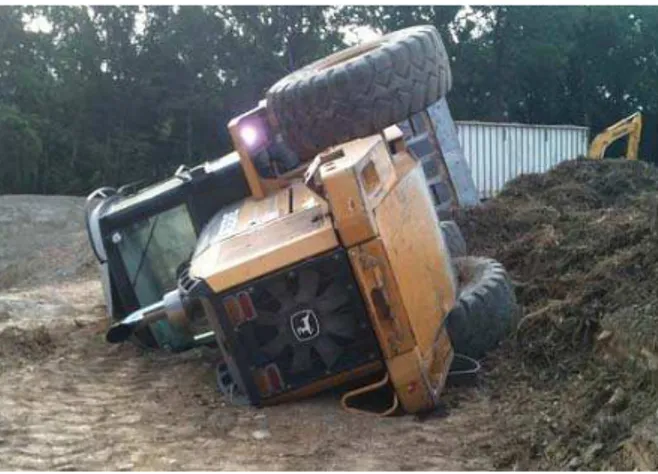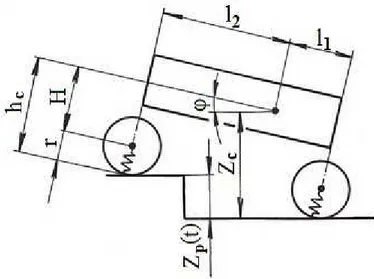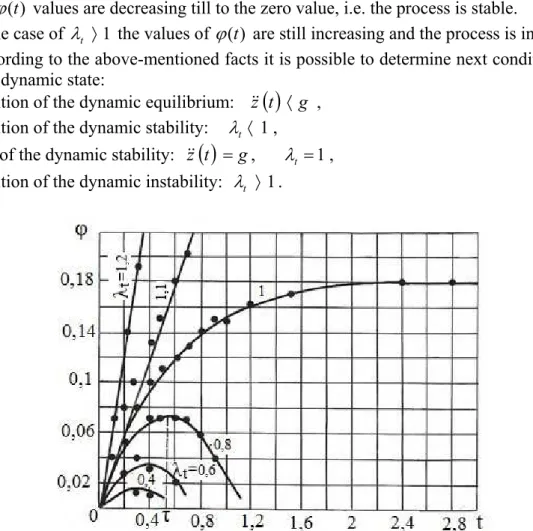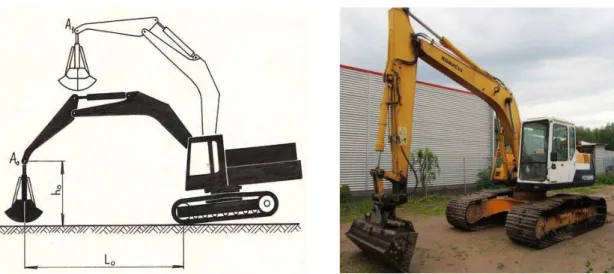MOBILE WORKING MACHINES
Summary. This paper describes an investigation of the dynamic stability, which is specified for the mobile working machines. There are presented the basic theoretical principles of the stability theory together with an introduction of two illustrative examples of the dynamic stability analysis.
Keywords: mobile working machine, dynamic stability, verification of stability.
ANALIZA I OPTYMALIZACJA STABILNO CI DYNAMICZNEJ
JEZDNYCH MASZYN ROBOCZYCH
Streszczenie. Niniejszy artykuł opisuje badanie stabilno ci dynamicznej ze szczególnym uwzględnieniem jezdnych maszyn roboczych. Opisano w nim podstawowe teoretyczne zasady teorii stabilno ci wraz z przedstawieniem dwóch przypadków ilustruj cych analizę stabilno ci dynamicznej.
Słowa kluczowe: mobilna maszyna robocza, stabilno ć dynamiczna, weryfikacja stabilno ci.
1. INTRODUCTION
The stability of machine plays an important role among the most important functional characteristics of the wheeled mobile working machines and the caterpillar mobile working machines. The stability is a substantial condition with regard to the machine working ability as well as due to a safety of these machines.
There are two main categories of the stability: the static stability and the dynamic stability. The static stability is an ability of the machine to keep its equilibrium position during action of constant external loading. The dynamic stability represents a resistance of the machine to turnover due to external forces that are changing during the current machine operation. The static stability is examined at the machine static position and the dynamic stability is verified during performing of the determined machine working activity.
The consequences of the loss of stability are generally well-known and they do not need to be commented specially, e.g. Fig. 1.
1
Faculty of Mechanical Engineering, The Technical University of Košice, Košice, Slovak Republic, e-mail: peter.bigos@tuke.sk
2
Fig. 1. Loss of mobile working machine stability during operation Rys. 1. Spadek stabilno ci w mobilnej maszynie roboczej podczas pracy
2. DYNAMIC STABILITY
In order to verify the dynamic stability it is necessary to investigate various variable forces. These forces are defined as the functions of time and functions of the system position. If the system is situated in an equilibrium position in a certain time moment, this situation can be changed suddenly and very quickly just in the next moment. From this reason it is necessary to investigate the system behaviour during action of the various external dynamic negative impacts (failures), i.e. to search a movement of the given system as a whole. Using the mathematical apparatus it is possible to solve this task by means of the corresponding differential equations of motion.
In order to understand the all important phenomena that are connected with the dynamic stability of the mobile working machines, there are presented in the next part of this paper the relevant general definitions from the area of mechanics, which is describing the dynamic equilibrium of a mechanical system. The principle consists in consideration of such situation when the system is shifted from the stable position (dx) with a small speed (dv). The stability is kept in such case if the deviation from the previous position remains small.
According to the Fig. 2 it is possible to say that the dynamic equilibrium of the given machine will be kept at that time, as the failures that are disturbing its moving mechanisms cannot cause a loss of contact between the machine and the ground. Let the z = z(t) is a vertical distance of any point of the machine from the horizontal support. So, it is possible to define the next condition (1): if the vertical acceleration z
t of the machine will be less thanthe acceleration of gravity g, the machine remains in a stable contact with the ground:
t gz
(1)
or
, 0 cos
cos . sin
.
2
r H
l z
zC P
(2) where:
t z - is the vertical acceleration of the machine (m.s-2),
Fig. 2. Dynamic model of a wheeled mobile working machine Rys. 2. Model dynamiczny kołowej mobilnej maszyny roboczej
In order to determine the conditions (1) a (2) it is necessary to solve the differential equations of the swinging motion or the rollover motion of the machine with regard to the variables (zc; ; z(t)) and to put such obtained values into the relation (2).
The next behaviour of the machine after losing of contact between the machine and the ground depends on the machine dynamic parameters, machine design characteristics and external influences (acting failures). There are two possible scenarios in such case.
The first situation is when the machine is able to return back to the basic stable position after an initial deviation. This is the suitable result of a disturbing situation and it is possible to say in this case that the machine is stable dynamically.
However, the second situation is unfavourable, because in the second case the initial deviation of machine is increasing and the machine is overturning, i.e. the machine is instable dynamically.
So, the decisive factor of stability is a movement tendency of machine after the initial deviation from the original stable position.
According to the [3] there is defined the indicator of stabilityt by the relation (3), where D
is a set of factors and R is a reserve angle of stability: . R t
tg D
(3)
If 1t , so the (t)values are increasing initially during a certain time and after this time the(t) values are decreasing till to the zero value, i.e. the process is stable.
In the case of t 1 the values of (t) are still increasing and the process is instable. According to the above-mentioned facts it is possible to determine next conditions of the machine dynamic state:
condition of the dynamic equilibrium: z
t g , condition of the dynamic stability: t 1,
limit of the dynamic stability: z
t g, t 1, condition of the dynamic instability: t 1.
Fig. 3. Time behaviours of the
t function for the various values of the tRys. 3. Przebieg czasowy funkcji
t dla różnych warto cit2.1. Evaluation of Stability
The reserve of stability S can be defined as a ratio of the limit angle of stability S and the real angle of terrain incline :
, R S
S S
S
(4)
whereas = S- R and in the case of the stability condition it should be < S, i.e. the terrain should be inclined less than is the limit stability angle.
called coefficients of the loading capacity exploitation, i.e. the next ratio values: S R S S S , S R S M M M M and M M M S R S M . KL F F Q
For example, for the wheel loaders there is defined the coefficient of stability 2
S
KF according to the technical standard. This condition means that if the limit angle of the slope is 20o, the permitted angle is only 10o.
The high level of stability reserve applied for the wheeled machines or for machines with the caterpillar chassis is necessary in order to meet the safety requirements also during acting of various dynamic factors.
The minimum value of the stability reserve is: . .
3 ,
1 arctg D K S S (7) Taking into consideration calculations performed according to the [3] it is possible to say that the loading capacity of the mobile working machines can be increased about 80% on condition that the dynamic stability will be exploited correctly.
3. REAL EXAMPLES OF DYNAMIC STABILITY DETERMINATION
There are presented in the following part two typical examples of the dynamic stability evaluation in the case of the mobile working machines. The first occurrence is a situation without the machine travelling, Fig. 4 and the second is situation with travelling, Fig. 5. In the both cases there is given also the final relation describing the indicator of stabilityt, which is a dimension-less value according to the [3].
The first case of the dynamic stability investigation without machine travelling enables to realize the stability verification process experimentally using such equipment, which is intended for the static stability testing (e.g. the tilting platform).
3.1. Sudden Stopping of Jib Lowering
Fig. 4. Dynamic stability of the mobile working machine without travelling Rys. 4. Stabilno ć dynamiczna mobilnej maszyny roboczej podczas postoju
Decision about the dynamic stability is obtained by means of the following two relations:
. ,.
sin . cos
. . .
2 2
0 0
0 0
0
R t
tg
p p
J
h L
v C
(8)
, cos .
cos . .
. 1
S R J
h g m p
(9)
where is:
C0 - the stiffness of the working equipment reduced to the end of jib, point A0 (N.m-1),
v - the speed of the jib lowering (m.s-1),
L0 - the radius of the jib with regard to the axle of machine rollover (m),
h1 - the height coordinate of the point A1 (m),
o
- the degree of the jib rotation (º),
Fig. 5. Dynamic stability of the mobile working machine during travelling Rys. 5. Stabilno ć dynamiczna mobilnej maszyny roboczej podczas jazdy
The dynamic stability is defined using the next couple of relations:
,. . .
. .
2 2
g m
F F tg
p k p J
h v C
V a R
C K
t
(10)
, cos
. cos . . .
S R C
J h g m p
(11)
where is:
C - the reduced stiffness of the system „working equipment - material“ (N.m-1),
vk - the speed of machine (m.s-1),
Fa - the adhesive (pushing) force (N),
FV - the rolling resistance of the travelling unit (N),
m.g - the total weight of machine (N),
k - the natural frequency of the system „working equipment - material“ (s-1),
hC - the height coordinate of the machine point of gravity (m),
J - the moment of inertia of the machine about the axis of rollover (kg.m2).
4. CONCLUSION
Acknowledgment
This paper was elaborated in the framework KEGA 050TUKE-4/2014 Reserach oriented for an innovation of educational programs and for finalisation of a specialised laboratory intended for the trans-operational transport and logistics.
Bibliography
1. Gulan L., Mazurkievič I.: Mobilné pracovné stroje. Teória a metódy projektovania. Slovenská Technická Univerzita v Bratislave, 2009.
2. Vaněk A.: Moderní strojní technika a technologie zemních prací. ACADEMIA, Praha 2003.
3. Goberman a kol.: Teória i konstrukcia strojiteľnych i dorožnych mašin. Mašinostrojenie, Moskva 1979.




